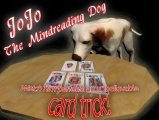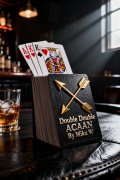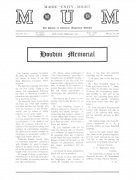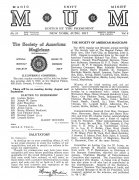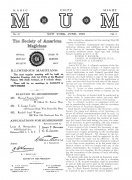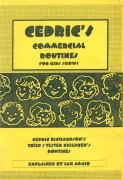Magic & Mentalism
Subtopics
Mentalism & Spiritism Cards Magazines & Journals with Demo Video DVD (download+stream) DIY, Makers & Builders Books (printed) Video clips (download) Theory, Articles & Reviews for Beginners Coins, Chips & Buttons Illusions, Escape & Stage Biographies & History in German (Deutsch) Marketing, Selling & Business Matters Audio Balls, Eggs, Dice & Cups Memory & Mnemonics Science & Math Tricks Paper & Paper Money Ropes, Ribbons, Strings & Reels Comedy Magic Physical (Non-Digital) Tricks & Gimmicks Patter, Plots & Scripts Compilations in Italian (italiano) Kids & Children Hypnosis & NLP Rings Cigarettes, Candles, Matches & Fire Liquids, Chemicals & Bottles Phone, Apps & eTricks Published 1800-1899 Silks & Flags DVD & Video (disc) Hands, Fingers & Body Thimbles Catalogs Published before 1800 Chapeaugraphy Instruction Sheets Ventriloquism in French (français) in Spanish (español) Second Hand Animals Gospel Magic Gift Cards & Donations Pickpocket Fiction for Resellers Free in Japanese (日本の)Authors
Products
Once Upon a Magic Show
Daryl Hurst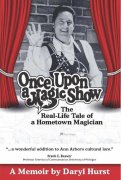
The real-life tale of a hometown magician.
Once Upon a Magic Show is the inspiring, funny, sometimes poignant story of how a self-styled "ordinary Joe" from Ann Arbor, Michigan, grew up to become an accomplished "Magic Man," who, for decades, brought joy and amazement to audiences of all ages.
From the moment his third-grade magic routine came to its hilarious conclusion, Daryl Hurst was certain his vocation was to be a magician, someone whose innate talent was destined to cement his hometown reputation. Indeed, Daryl's school years were marked by steady acquisition of the tools and experience...
MUM: Magic Unity Might (1911-1927)
Charles Roltare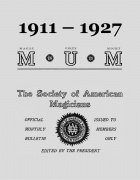
The Society of American Magicians was founded in 1902. Their first society journal was published in October 1911 on the suggestion of Charles Roltare. The currently serving president was the editor. Its content is a mix of meeting notes, news, opinions, and articles on historical matters, a good portion of which has been contributed by Harry Houdini.
1st edition 1911, PDF 821 pages.
UnMe Special Bundle 10: Power Stacks Bundle
Unknown Mentalist
On the occasion of the 10th birthday of the Unknown Mentalist (yes, the Unknown Mentalist was born in 2015 and he is now all of 10 years old), for the next 10 weeks, you will be able to buy Special Bundles every week for never-before & neverßagain prices. Each Special Bundle will be live for only 10 days. So watch out for the Lybrary newsletter every week as this is exclusive to Lybrary only. You can catch the Special Bundles on the "On Sale" page of Lybrary also. The biggest buyer of Special Bundles during these 10 weeks put together will get a Nostradum Wallet worth $63 free. This special...
The Impossible Card Discovery
Dustin Marks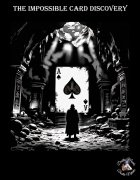
In the art of magic, the ultimate goal is to create a moment of pure, unadulterated astonishment - an experience so clean and impossible that it transcends mere trickery and feels like real magic. For the spectator, this requires an effect built on a foundation of total fairness. The challenge is to guide them to a place where the only remaining explanation is: your spectator has just experienced the impossible.
Effect: Imagine this from your spectator's perspective. You are handed a deck of cards. You inspect it and shuffle the deck. When you are satisfied, the magician turns his back....
Magic a la Card
Mago Marko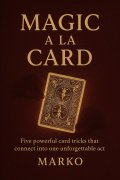
Five effects that connect into one routine.
Tired of forgetting your best tricks when an audience asks for a spontaneous performance? Magic a la Card solves the routine problem, offering a complete, five-effect card set that requires zero sleight of hand. This is a fully sequenced act designed to build in crescendo to a powerful climax: a sleightless Card in the Wallet effect. From the psychological deception of The Lie Detector (where the back of the card predicts the outcome) to a modernized 21 Card Trick and an impossible Mathematical Prediction, the pack is prearranged, and the tricks...
Extra Sympathy
Ian Baxter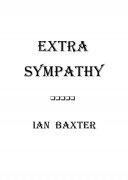
Annemann's Synthetic Sympathy is a long-regarded classic of card magic, with a history dating back to 1921 when Charles T. Jordan put out his original version. Annemann slotted it into an early edition of his magazine The Jinx. It took off like wildfire and Jean Hugard promptly included the Annemann update in Encyclopedia Of Card Tricks, further enhancing its popularity. Then Max Holden jumped on the bandwagon and published it yet again, including it in his Annemann compendium Full Deck Of Impromptu Card Tricks.
Holden was particularly...
Just Another Five
Bob Malinchock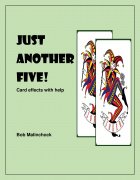
This ebook contains only five card tricks that require some additional help, a gimmick, or an altered card. Presented is a variety of straightforward effects with little demand on one's skill in sleight of hand.
- Inspired Marked Card
- In Plain Sight
- Margery Seance
- Unseen
- Whispering Jokers
1st edition 2025, PDF 20 pages.
Magic Painting
Ian Adair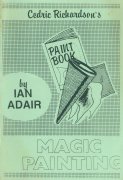
This is Cedric Richardson's routine that uses just a normal-looking paint book, with black and white drawings, ready to colour by the children. What could be simpler? They often say 'Keep it Simple' and that's what Cedric did. Yet he managed to introduce real, solid bits of business which made his routine stand above all others.
1st edition 2000, PDF 8 pages.
MUM Volume 15 (December 1925 - January 1927)
Charles Roltare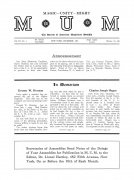
- No. 148
- No. 149
- No. 150: Special Notice to Members of All Assemblies
- No. 151: Houdini Has Magicians' Night in Philadelphia
- No. 152: Harken to Ye Editor
- No. 153: Annual Banquet
- No. 154: Laws for Spiritualists
- No. 155: A Time for New Resolutions
- No. 156: Houdini in Memoriam
- Nos. 157, 158: A Few of the Tributes
1st edition 1925, PDF 41 pages.
MUM Volume 14 (July 1924 - November 1925)
Charles Roltare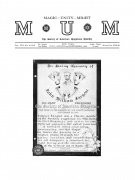
- Nos. 136, 137, 138: In Loving Memory of John William Sargent
- No. 139: As It Should Be! / Oscar S. Teale
- No. 140: In Memoriam Francis J. Martinka; Ben Ali Bey
- No. 141: Is This Merely a Question of Veracity? If So, Who is at Fault?; Ben Ali Bey (continued)
- No. 142: Wah Chan / John Mulholland
- No. 143: An Open Letter / Oscar S. Teale; Physical Phenomena - Margery fails to win the Scientific American Prize and now she follows all other alleged supernormals / Oscar S. Teale
- No. 144: Dr. Johann Nepomuk Hofzinser
- No. 145: In Memory of Mr. Alfred Becks
- No. 146
- No. 146-147: The Twenty-First Annual...
MUM Volume 13 (July 1923 - June 1924)
Charles Roltare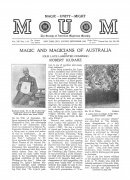
- Nos. 124, 125, 126: Magic and Magicians of Australia / Robert Kudarz
- Nos. 127, 128: Society of American Magicians to Fight Exposures
- No. 129: Random Thoughts on Magic / Henry R. Evans
- No. 130: A Bit of Magical Archeology / G. G. Laurens
- No. 131: Head shots of Presidents of the Society of American Magicians
- No. 132: Hands Across the Sea / Will Goldston
- No. 133
- No. 134
- No. 135: Banquet of the Society of American Magicians
1st edition 1923, PDF 41 pages.
MUM Volume 12 (July 1922 - June 1923)
Charles Roltare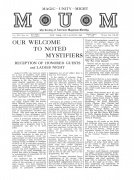
- Nos. 112-113: Our Welcome to Noted Mystifiers
- Nos. 114-115: Magic and Magicians in New Zealand and Australia / Robert Kudarz
- No. 116: Magic and Magicians in New Zealand and Australia (continued)/ Robert Kudarz
- No. 117: Well! Well! Look What Is Going On
- No. 118 Robert Kudarz dies; William Berol Lamented
- No. 119: T. Nelson Downs Mystified
- No. 120: Concerning Robert Kudarz, late Compeer No. 167
- No. 121: A Carnival of Magic
- No. 122: Houdini Entertains 500 Kiddies in San Francisco / H. Syril Dusenberry
- No. 123: Our Annual Banquet
1st edition 1922, PDF 55 pages.
MUM Volume 11 (July 1921 - June 1922)
Charles Roltare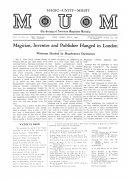
- No. 100: Magician, Inventor and Publisher Hanged in London
- No. 101: Adam Hull Shirk Visits New York; Grave of the Great Lafayette
- No. 102: Meeting of the Parent Assembly; Historical Data Sawing a Lady in Two
- No. 103: News of November Meeting; Graves of Ling Look and Yamadeva
- No. 104: An Open Letter to All Editors / Harry Houdini
- No. 105: Unknown Facts About Philippe, father of the "Gift" Show / Harry Houdini
- No. 106: The Evolution of Superstition / Joseph F. Rinn
- No. 107: Great Victory for Magic
- No. 108: Dean Harry Kellar dies
- No. 109: Membership Cards Nearing 1000 Number
- No. 110:...
MUM Volume 10 (June 1920 - June 1921)
Charles Roltare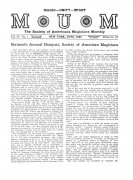
- No. 87: Sixteenth Annual Banquet, Society of American Magicians; Signor Blitz Before Abraham Lincoln / Oscar S. Teale
- No. 88: Breslaw, one of the great mystifiers of the eighteenth century / Harry Houdini
- No. 89: Breslaw (continued)
- No. 90: Philadelphia, a historical seventeenth century magician / Harry Houdini
- No. 91: Tributes to John William Sargent; Philadelphia (continued)
- No. 92: Ladies' Night
- No. 93: Hell Gate to Golden Gate
- No. 94: Trewey - an Appreciation / Henry R. Evans
- No. 95: Frizzo - Master Magician / Harry Houdini; A Comparison of the Oldest Magic with Modern Illusions ...
MUM Volume 9 (June 1919 - May 1920)
Charles Roltare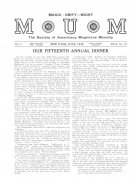
- No. 75: Our Fifteenth Annual Dinner; William Davis Leroy; Mrs. Francis J. Martinka
- No. 76: Magic and Magicians - past and present - in Australia and New Zealand / Robert Kudarz
- No. 77: Magic and Magicians in Australia and New Zealand (continued); Houdini in "The Grim Game"; Impressions of a Night with Dr. Wiljalba Frikell / Frederick Eugene Powell
- No. 78: Dissertation of Cagliostro / G. G. Laurens
- No. 79: Jonathan Harrington / Edwin Fay Rice
- No. 80: Professor Hoffmann, Angelo Lewis, The brightest star in the firmament of magical literature / Harry Houdini
- No. 81: Does Sir Conan Doyle's...
MUM Volume 8 (June 1918 - May 1919)
Charles Roltare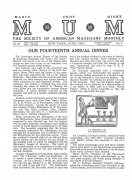
- No. 63: Our Fourteenth Annual Dinner; Golden Gate Assembly; Passing of Paladino; The Mishaps of a Mystic / Edwin Fay Rice
- No. 64: Kit Clarke, Veteran Manager of Magicians Dies
- No. 65: The Life and Five Years Before the Public, of Robert Nickle, the World's Prestidigitateur
- No. 66: One of Our Members at the Front; The Princes of German are Shaking Dice for the United States / Herbert Quick
- No. 67: Kit Clarke and His Contempories / C. Fred Crosby
- No. 68: Kit Clarke and His Contempories / C. Fred Crosby
- No. 69: Katterfelto: One of the Most Interesting Characters in the History of Magic....
MUM Volume 7 (October 1917 - May 1918)
Charles Roltare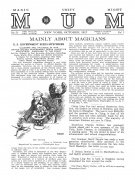
- No. 55: Mainly about magicians; Battles of Famous Mystifiers / Harry Houdini
- No. 56: A Historical Event - Kellar's Farewell; Battles by Famous Mystifiers (continued) / Harry Houdini
- No. 57: John Henry Anderson - Speaks for Himself; Edwin Fay Rice - a retired past master of magic; About the Magic Wand / G. G. Laurens
- No. 58: The Story of the Gift Shows / Kit Clarke; Houdini's Vanishing Elephant
- No. 59: An American Magician Who Died in an English Poorhouse / Harry Houdini; Mind Reader W. Irving Bishop's Mother Passes Away; A Paradoxical Perplexity: Dr. Samuel C. Hooker's Phenomenal Presentation...
MUM Volume 4 (November 1915 - May 1916)
Charles Roltare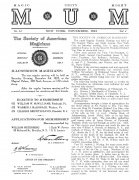
- No. 34: John Philip Quinn; MacAllister, the celebrated Wizard and Magician; Prof. Charles Huot
- No. 35: Houdini; The Wizard of the North; A Reminiscence; Magic
- No. 36: Anthony Martinka; The Rising Cards; Juggling for Exercise; Love's Necromancy; Ten Little Magicians
- No. 37: The Fakir of Oolu; Magic Number; Are You a Magician?; An Expose
- No. 38: The Rising Cards; Robert Nickel; The Chinese Magician
- No. 39: Frank Peppler Knight; Augustus F. Hartz; Prof. E. C. Taylor; Hunter and the Pipe
- No. 40: President Sees Houdini Escape from Water Tank; What Dr. Wilson says about the annual banquet
MUM Volume 3 (September 1914 - September 1915)
Charles Roltare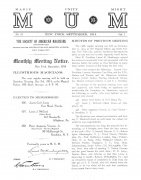
- No. 22: Minutes of Previous Meeting; Vacation Time is Over; Real Magic; Judge Not
- No. 23: Minutes of Previous Meeting; Secretary's Column; The Harmless Necessary Knocker; Harry Kellar
- No. 24: What is There in it for Me?; Laurant describes a magician's profession
- No. 25: Be Not Weary in Well-Doing; The Magic of Over One Hundred Years Ago; Prof. Hoffmann; Originator of the Non-Assisting Clock; Bust of Horace Goldin
- No. 26: Some Valntines in Limerick Lines / Uguess Hoo; Robert Heller
- No. 27: Long-Distance Messages; From Professor Charles Huot
- No. 28: Ye Editor Speaks; Magicians Fool Each...
MUM Volume 2 (October 1912 - June 1914)
Charles Roltare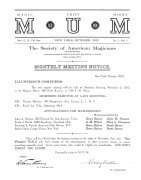
Note that numbers 11 and 12 were never published.
- No. 1: Amendment to the By-Laws
- No. 2: Signor Antonio Blitz
- No. 3: The Elevation of Magic
- No. 4: Official Report of the SAM
- No. 5: Will Goldston, our London Representative, chats about his career
- No. 6: Richard Van Dien, Secretary of the SAM
- No. 7: Elmer P. Ransom; Introspection
- No. 8: Charles Roltare
- No. 9: Dr. Albert M. Wilson; The Tenth Annual Dinner; A Question of Priority
- No. 10: An Exposure
- No. 13: List of Members of the SAM
- No. 14: The Social; A Game of Life (poem)
- No. 15
- No. 16: Ladies' Night of the SAM
- No. 17: A Reminiscence...
MUM Volume 1 (October 1911 - July 1912)
Charles Roltare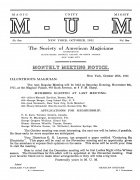
- No. 1: Our Policy; Magic is Dead!; Representatives; $5 For a Name; Jealousy; Annual Banquet; Our Entertainments
- No. 2: Conjuring by Electricity / G.G. Laurens
- No. 3: Professional Ethics; Jack Norworth; Werner Says; Many Thanks
- No. 4: Our Minister Magician; Extra Copies; The Growth of Flowers; Leroy's Letter; Annual Big Magic Show; Annual Banquet; Illustrous Wilson; Our Lyceum Magicians; An Invitation; The SAM Magicians
- No. 5: Marvill Magician; Keep It Up; Come Again; The SAM Magicians; The Social Session; Supplement
- No. 6: A Slight Correction and Reminiscence; Originality; Did It Ever Occur...
Grosse Kartenschule 5
Roberto Giobbi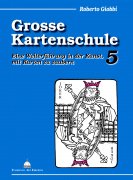
Eine Weiterführung in der Kunst, mit Karten zu zaubern.
Roberto Giobbi's Grosse Kartenschule, bisher in acht Sprachen erschienen, ist die am weitesten übersetzte Buchreihe in der Geschichte der Zauberkunst. Jede Version wurde zum sofortigen Bestseller.
Es ist die umfassendste Publikation ihrer Art und wurde von Fachleuten auf der ganzen Welt als die "Bibel des modernen Kartenkünstlers" bezeichnet. Dieser fünfte Band enthält die detaillierte Beschreibung von weiteren modernen Techniken und Methoden, über 30 der besten klassischen Kartenkunststücke, sowie zahllose theoretische und...
Who Was Gombert and Why Should We Care?
Jon Racherbaumer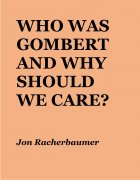
The Gombert Pass, as published in the Gen Volume 22, Number 3, July 1966, has a complicated and mysterious past. At some point, some card experts believed Gombert was a pseudonym of Edward Marlo. Jon Racherbaumer traces its history and finds and connects with Jan Gombert, the author of the article in the Gen.
- Meetings And Passings: Memes And Themes
- Gombert Pass Reverse
- One-Third Of The Gombert Pass
- Cervon's Invisible Reverse
- Turnover Pass Reverse
- One Fantastic Move
- Bibliography
- Finding Gombert
1st edition 2004, PDF 25 pages.
Novel Hand Shadows
William John Hilliar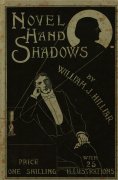
An original series of 25 silhouettes. As presented by William Hilliar for three consecutive months at the Great Paris Exhibition, 1900.
- Preface
- Introduction
- Dog And Rabbit
- A “New” Rabbit
- French Chef & Frying Pan
- The Man And The Bottle
- President Mckinley
- Mr. Gladstone
- Napoleon
- The Giraffe
- The Preacher
- Woman And Spoon
- The Swan
- Man With Pipe
- The Conductor And Lady Vocalist
- The Horse
- The Dentist
- The Snuff-Taker
- The Fowl
- The Dancer
- A French Advocate
- The Woman At Her Toilet
- Mr. And Mrs. Caudle
- A Good Story
1st edition 1900, 47 pages; PDF 28 pages.
Quadruple Elevator
Miku W.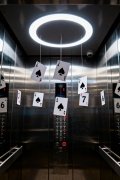
An adaptation of a classic card routine - the Spades 1, 2, 3, and 4 travel between the top and bottom of the deck, finally gathering together on top. Just when you think it's over - no, the magic has only begun. The Spades 5, 6, 7, and 8 appear on top of the deck, the Spades 9, 10, J, and Q appear on the bottom, and the final Spade King rises to the very top of the deck. For full details, see the performance video.
1st edition 2025, video 8:00.
Card from Handkerchief
Dustin Marks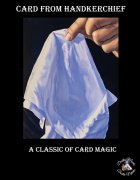
Effect: The spectator freely selects a card under the fairest of conditions. It is lost in the deck by the spectator. After placing the cards in the cardbox, it is wrapped in a handkerchief. The spectator holds the handkerchief and gives it a shake. His card falls to the table.
Description: This is a classic of card magic. Under the fairest possible conditions, a spectator selects a card from a deck that he has shuffled. The deck is placed in the cardbox and wrapped in a handkerchief. It is dropped by the spectator instead of the magician. This version uses an ungimmicked opaque handkerchief...














